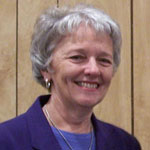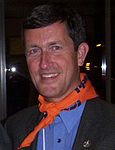1995 New Democratic Party leadership election
| |||||||||||||||||
| |||||||||||||||||
| |||||||||||||||||
| Date | October 12 − 15, 1995 |
|---|---|
| Convention | Ottawa, Ontario |
| Resigning leader | Audrey McLaughlin |
| Won by | Alexa McDonough |
| Ballots | 1 |
| Candidates | 3 |
The 1995 New Democratic Party leadership election, was held in Ottawa, from October 12–15 to elect a leader of the New Democratic Party of Canada. This convention was held because Audrey McLaughlin retired as federal leader. Although Svend Robinson led on the first ballot, he conceded the leadership to Alexa McDonough, who was appointed by a motion put forward by Robinson. This was the last NDP leadership convention that was decided solely by delegates attending and voting at the convention.
Background
As the fortunes of the Nova Scotia NDP were slowly rising during the mid-1990s, the same could not be said of its federal counterpart. The 1993 Canadian federal election was an unmitigated disaster for the NDP.[1] Under Audrey McLaughlin's leadership, the party suffered its worst defeat since the late 1950s in terms of seats, and the worst showing[1] for a federal social-democratic party in the 20th century, with just seven percent of the vote.[1] The party had nine seats, three short of the twelve seats needed to have official party status in the House of Commons, and all the extra funding, research, office space and Question Period privileges that status accords.[1] In the aftermath of the 1993 election, the party set about reforming its policies and purpose, with McLaughlin announcing on April 18, 1994 that she would step down as leader by 1996.[2] McLaughlin, faced with internal squabbles like the ones that occurred in the Nova Scotia party back in 1980, advanced her departure from the end of 1996 to the end of 1995.[3] With an internal party atmosphere that could best be described as toxic, Alexa McDonough, Lorne Nystrom, and Svend Robinson, entered the leadership campaign in the spring of 1995.[4] The conditions were similar to the ones that McDonough faced during her first leadership campaign in Nova Scotia during 1980: a divided party that was self-immolating.[4]
Leadership ballot
To make it on the convention ballot, a leadership candidate had to win one of the primaries held throughout the country ahead of the convention. A candidate could also make it on the ballot if a 25% national vote threshold was reached. Herschel Hardin was the only candidate who failed to win a primary and he was thus excluded from the convention ballot. Prior to the NDP leadership convention on October 14, 1995, McDonough was widely viewed as an also-ran behind the leading contenders, Svend Robinson and Lorne Nystrom.[5] Nystrom won the primary, with 44%, well ahead of Robinson and McDonough.
Quebec Primary
| Candidate | Percentage |
|---|---|
| Svend Robinson | 44.94% |
| Lorne Nystrom | 34.82% |
| Alexa McDonough | 10.12% |
| Herschel Hardin | 10.12% |
| Total | 100% |
Atlantic Primary
| Candidate | Percentage |
|---|---|
| Alexa McDonough | 68.50% |
| Svend Robinson | 21.10% |
| Lorne Nystrom | 7.24% |
| Herschel Hardin | 3.15% |
| Total | 100% |
Ontario Primary
| Candidate | Percentage |
|---|---|
| Svend Robinson | 43.67% |
| Lorne Nystrom | 26.17% |
| Alexa McDonough | 22.87% |
| Herschel Hardin | 7.29% |
| Total | 100% |
BC/North Primary
| Candidate | Percentage |
|---|---|
| Svend Robinson | 50.80% |
| Lorne Nystrom | 29.32% |
| Alexa McDonough | 12.03% |
| Herschel Hardin | 7.85% |
| Total | 100% |
Prairies Primary
| Candidate | Percentage |
|---|---|
| Lorne Nystrom | 71.86% |
| Svend Robinson | 18.07% |
| Alexa McDonough | 5.60% |
| Herschel Hardin | 4.47% |
| Total | 100% |
Labour Primary
| Candidate | Percentage |
|---|---|
| Lorne Nystrom | 38.02% |
| Svend Robinson | 32.32% |
| Alexa McDonough | 28.46% |
| Herschel Hardin | 1.20% |
| Total | 100% |
Primaries - Total
| Candidate | Percentage |
|---|---|
| Lorne Nystrom | 44.69% |
| Svend Robinson | 32.06% |
| Alexa McDonough | 18.47% |
| Herschel Hardin | 4.78% |
| Total | 100% |
First Ballot
| Candidate | Delegate Count | Percentage |
|---|---|---|
| Svend Robinson | 655 | 37.8% |
| Alexa McDonough | 566 | 32.6% |
| Lorne Nystrom | 545 | 31.5% |
| Total | 1,735 | 100% |
Aftermath
Robinson's move helped to unify the party and shake his image as a lone wolf.[7] After the vote, Robinson met with about 200 of his supporters, who were shocked, and in some cases, outraged at what he did.[7]
In the 1997 election, McDonough's first as leader, the party won 21 seats, including a historic breakthrough in the Atlantic provinces. McDonough was elected as the Member of Parliament for the federal riding of Halifax, the same riding in which she ran unsuccessfully in 1979 and 1980. She would win Halifax three more times until she retired from politics in 2008, and the party did not lose official party status during her leadership.
Notes
- ^ a b c d Globe Editorial (1993-10-28). "Retooling the New Democrats". The Globe and Mail. Toronto: CTVglobemedia. pp. A26.
- ^ Delacourt, Susan (1994-04-19). "NDP plans to redesign the left: McLaughlin to give up helm". The Globe and Mail. Toronto: CTVglobemedia. pp. A1, A6.
- ^ Howard, Ross (1995-01-23). "NDP sets new style for leadership race". The Globe and Mail. Toronto: CTVglobemedia. pp. A1, A2.
- ^ a b McCarthy, Shawn (1995-10-15). "McDonough best choice to rebuild federal NDP". The Toronto Star. Toronto: Torstar. pp. A4.
- ^ a b Windsor, Hugh (1995-10-16). "Second fiddle leads NDP: McDonough wins, Robinson gives in". The Globe and Mail. Toronto: CTVglobemedia. pp. A1, A5.
{{cite news}}: Cite has empty unknown parameter:|pmd=(help) - ^ Harper, Tim (1995-10-15). "McDonough 'natural leader' from teens". The Toronto Star. Toronto: Torstar. pp. A5.
- ^ a b c d McCarthy, Shawn (1995-10-15). "New Democrats pick McDonough". The Toronto Star. Toronto: Torstar. pp. A1, A5.




